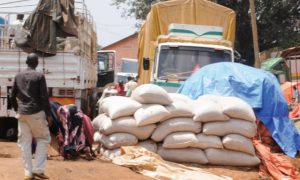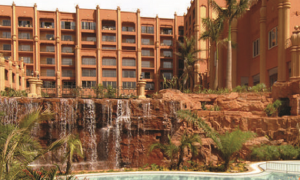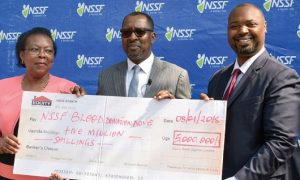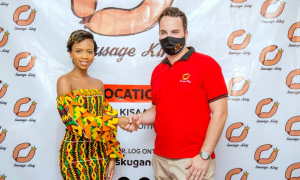
Kampala, Uganda | THE INDEPENDENT | Oliver Lalani is the Executive Director at Roofing Rolling Mills. He spoke to Isaac Khisa about Uganda’s steel industry and its future outlook.
What is your assessment of the performance of Uganda’s steel industry in the country at the moment?
Steel industry in Uganda has evolved over the years. Consumption of steel per capita was about 3 kgs compared with 24 kgs per annum in Kenya. But as the economy develop and become more and more industrialized, steel remains the backbone. The government has recently embarked on developing various infrastructural projects coupled with the increasing population, which are all opportunities for growth of this sector. As Roofings Rolling Mills, we grew by 10% to nearly 200,000 tonnes per annum in 2017, with steel bars being on the high demand, due to the ongoing construction of dams, bridges and roads. Uganda’s total steel market is around 585,000 tonnes per annum, with Roofings controlling about 25% of the market share.
As at the end of 2016, steel sector had a big fight with government over local content in the ongoing infrastructural development projects. How has that issue been resolved?
We are now getting contracts from the ongoing infrastructural development projects especially dams (Karuma and Isimba). Contractors are now buying 100% steel bars locally. Though we entered this area late since the dams are near completion, it has helped us to wrap up capacity of our plants.
How is the performance of the regional markets in general and South Sudan in particular as far as export of Ugandan steel is concerned?
Our exports are mainly destined to the Democratic Republic of Congo, Burundi, Rwanda, South Sudan, and Northern Tanzania. With regard to trade with South Sudan, business has slightly improved but not near to the level it was in 2011 before internal conflict broke out in 2013. Out of the total 4000 tonnes exported to the region a month, 15% is destined to South Sudan. We do hope that once South Sudan stabilise, it will stimulate growth of Ugandan companies.
You had a plan to set up a plant in Rwanda’s Export Processing Zone. How far have you gone with the proposed plan?
We had some challenges including delays in making business deals. However, we are on the ground through our distribution company called RML. We do not have land in Kigali at the moment but we shall look at that in the future.
What strategies are you taking to drive growth of Roofings Rolling Mills?
We ensure that we have right amount of stocks with us to serve the markets. We also ensure that our products are of high quality. Everything we do, breathe is quality. We also continue to be innovative, producing new products, new colours, and textures that suit the needs of our customers. We are currently in the process of adding two new forming lines to give different profiles to the people. We are therefore continuously enhancing and diversifying our product range within the steel and to ensure that we have the full solution under the same roof. Also, customers don’t get cheated at RRM.
You also had a plan to use local iron ore towards steel production. Any update?
At the moment, there’s no capacity to melt Ugandan Iron Ore. But we are ready to work with one company that is coming in so that we can have an off-take agreement in the production of Direct Reduce Iron that we are interested in. But in future, we are planning to expand to also have DRI plant which we can use to melt the ore. The biggest setback in this whole plan is that Uganda doesn’t have a reducing agent. This is because Iron Ore has a lot of impurities, with only 68% being steel. There’s a lot of coal or gas required to reduce the impurities but at the moment, importing coal from South Africa is very expensive. Natural gas is plentiful in northern Tanzania but we need a pipeline to transport all gas to the iron ore areas to melt the iron ore. We are working with the government most specifically, National Planning Authority, to have a more integrated steel industry in Uganda. It is therefore likely to take some time because are not interested in putting up a small operation and becoming inefficient.
Above all this, consumers are always looking forward for reduction in steel prices. Any hope of fall in prices soon?
Our prices are determined by the international steel prices. This year we have been quite fortunate that the shilling remained stable which is one of the factors in our price decisions. We still import most of our raw materials, all valued in dollars. However, the international steel prices has picked up mainly as a reduction in production capacity in China as they strive to control pollution amidst increased demand for steel products especially in the Far East and increase in oil prices. All these imply that are prices are going up. However, prices will fall once we increase our production and start to enjoy economies of scale as long as other factors remain constant.
Some challenges if, any, as you go a long with your business?
One of the many challenges is the quality of electricity. For instance, in Lubowa, we have small machines with small mortars and therefore it is not a heavy industry. But at the Namamve Business and Industrial Park, we run furnaces, rolling mills, cold rolling mills with huge mortars, and our electricity demand is about 15-20MW. The biggest challenge is now fluctuations in the electricity supplied which sets us back in terms of competitiveness in production as a result of increased costs. Luckily, Umeme is trying to sort us out with the setting up of a sub-station in our mill. The other challenge is availability of skills given the highly automated machines. We are trying to train our employees through sending especially engineers in Japan and German to enhance their skills.
How do you see 2018?
We see a lot of expectations especially with the planned investments in oil and gas industry. Our target as Roofing Rolling Mills is to grow volumes by at least 15% in 2018.
The post Good outlook for Uganda’s steel industry in 2018 appeared first on The Independent Uganda:.
via: Independent
More
411 UG brings you all the latest News and Ugandan Music. Browse Featured News, Entertainment, Current Affairs, Technology, Interviews, Relationships and much more.






































































Share this post: